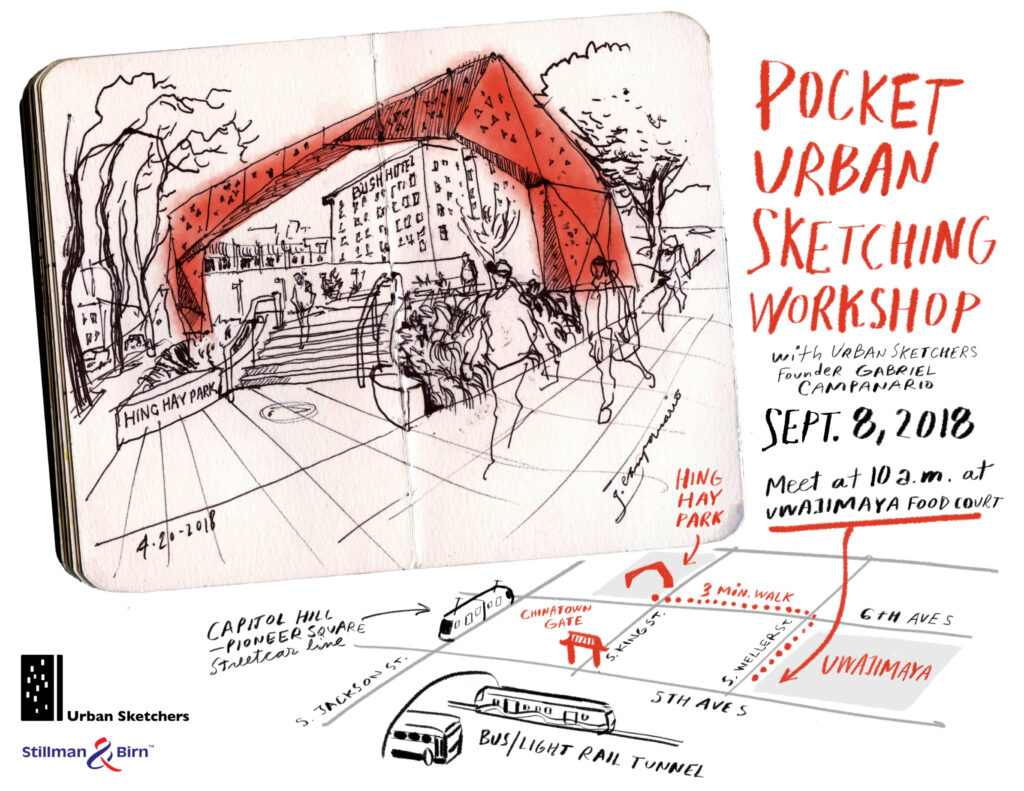
Summary: A crash course in urban sketching with a basic tool kit consisting of a pocket sketchbook, pencil, pen and watercolors.
If you are interested in becoming a better artist and urban sketcher like I was more than a decade ago, there’s nothing like drawing on a pocket sketchbook to fuel your motivation and sharpen your drawing skills. A small, easy-to-carry notebook makes sketching in public less intimidating and is ideal to create fast drawings on the go — and without calling too much attention from onlookers (hello, shy sketchers!).
Pocket urban sketching allows you to respond rapidly to any sketching opportunity. Through a series of exercises, I’ll teach useful contour drawing techniques, how to simplify complex scenes to make them fit on the page, and how to create dynamic page layouts where drawings and writing flow harmoniously within the page and from one page to another.
The workshop also includes a review of my urban sketching tools and useful drawing tips related to composition, perspective, tone and color.
By the end of the class, participants will have gained a basic understanding of what it means to be an urban sketcher and how to make on-location sketching a fun part of everyday life.
Drawing enthusiasts who are new to sketching from life will benefit the most from the class, but the joy of documenting the world on the pages of a pocket sketchbook can appeal to artists of all levels.
Schedule
Welcome and introduction (15 minutes)
Why draw on a small sketchbook? The four “Ps” of pocket urban sketching:
- Portability. A small notebook is easy to carry and whip out for a sketch at any given moment.
- Privacy. A minimal sketching kit is less likely to capture the attention of onlookers while you draw.
- Productivity. You can fill several spreads of a pocket sketchbook in the time it takes to complete a large drawing. Making more drawings means more practice.
- Pleasure. Pocket urban sketching can turn a moment of boredom into a fun and creative pastime.
Overview of sketching tools (pocket sketchbook, pencils, pens and watercolors).
Exercises
Up close and personal (60 min). In this exercise, participants learn how to examine and sketch subjects in their immediate field of vision and how to suggest the context necessary to evoke a sense of place. I demonstrate how to measure the chosen subjects and how to render them on the desired amount of space on the sketchbook page. Subjects may include elements of the urban landscape such as a street light, a vehicle, an interesting sign or an architectural detail.
Wide scene (60 min). In this exercise, participants learn how to examine and sketch a complex scene such as wide cityscape. I demonstrate basic perspective concepts, how to break down the scene into foreground, middle ground and background, and how to make it all fit on a sketchbook spread.
Tone and Color (45 min). Participants work on adding color to the sketches created during the previous exercises. Demo will show proper ways of mixing and applying watercolor to create soft and hard edges with the desired intensity and tonal value.
Learning goals
- Become comfortable with basic tools and techniques to practice urban sketching
- Become familiar with small format of the pocket sketchbook and learn to draw standing up
- Learn to fit wide scenes onto the small pages of the sketchbook
- Learn basic layout principles to arrange drawings and writing on the pages
- Learn basic tips to use watercolor successfully
- Gain drawing confidence by working through a sketch from start to finish without hesitation
Supply list
- Sketchbook: A free Stillman & Birn pocket sketchbook is included with registration.
- Pen. Bic pen. Uniball Vision and Micron Pigma are good brands of waterproof pens. You may also bring your own fountain pen.
- Pencil. A regular HB pencil would do, but you may also bring a pencil with a hard lead (i.e., 4H) and another with a soft lead (i.e., 3B)
- Watercolor kit. If you need to get one, Winsor & Newton and Royal Talens Van Gogh pocket kits are a good start.
- Waterbrushes (Niji or Pentel)
- Water container
- Rag or paper towel
- Brushes. My favorite is an angle brush.
For more details about my urban sketching kit, see this post.